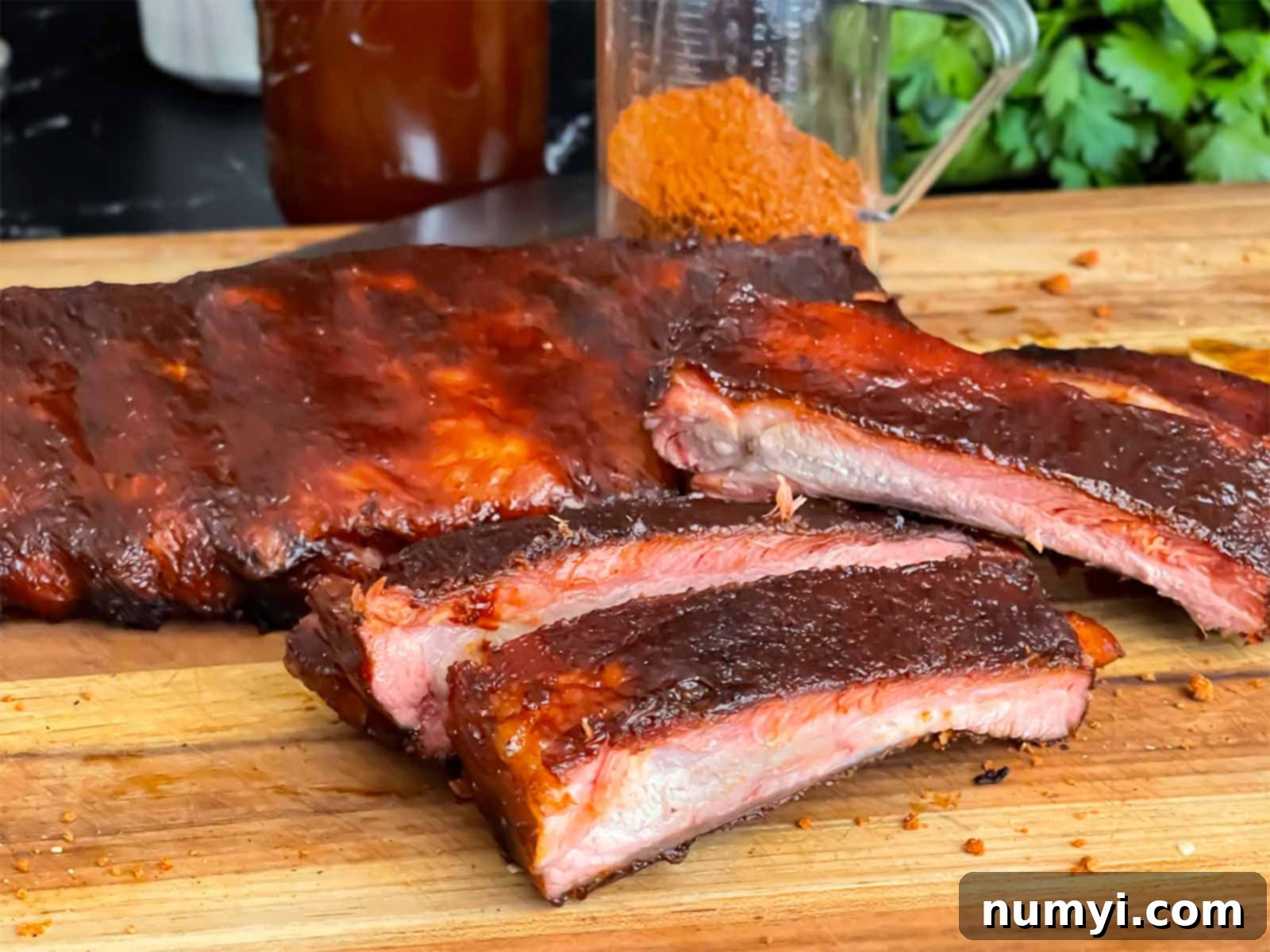Authentic Kansas City Smoked Ribs: Master the Art of Fall-Off-The-Bone Perfection
When the very thought of barbecue crosses your mind, chances are you’re dreaming of classic Kansas City barbecue ribs. These aren’t just any ribs; they are the epitome of smoky, sticky, deep caramelized meat candy, where each tender morsel effortlessly separates from the bone with the slightest bite or gentle tug. Get ready to embark on a culinary journey that will crown you the undisputed BBQ champion among your friends and family. You are going to absolutely love creating and devouring these sensational ribs!
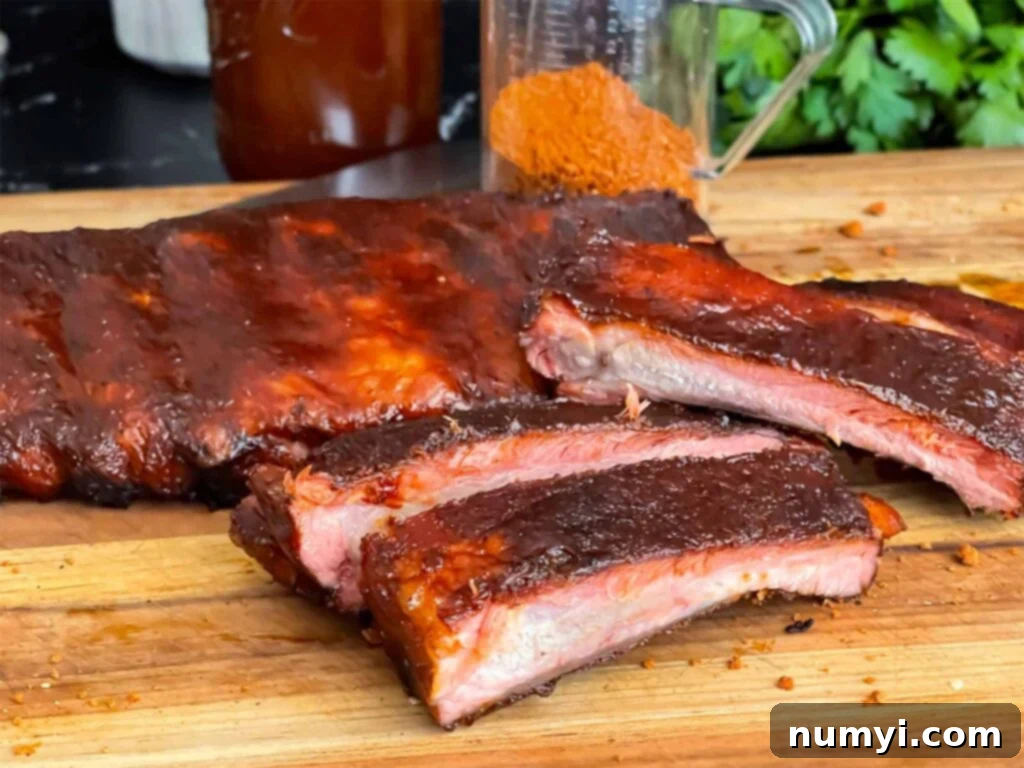
Why These Kansas City Ribs Will Become Your BBQ Obsession
Prepare yourself for a barbecue experience unlike any other. These Kansas City-style ribs are a glorious celebration of what true barbecue stands for: patience, passion, and unparalleled flavor. We’re talking about magnificent slabs of pork, meticulously seasoned with a robust spice rub and then slow-smoked over aromatic hickory wood. This careful process transforms the ribs, building an irresistible “bark” – a deep, glossy crust that crackles with a harmonious blend of sweet, tangy, and profoundly smoky notes. It’s a culinary alchemy that delivers perfection in every bite.
And let’s not forget the sauce. The signature Kansas City barbecue sauce is a masterpiece in itself. It’s wonderfully thick, sticky, and utterly finger-licking good. This iconic sauce boasts a masterful balance of rich brown sugar sweetness and a zesty, tangy kick. As it caramelizes onto the ribs during the final stage of cooking, it creates a lacquered, irresistible coat, ensuring each bite is pure BBQ nirvana. This isn’t just a meal; it’s a sensory feast, delivering bold, unforgettable flavors that resonate with the very soul of American barbecue tradition.
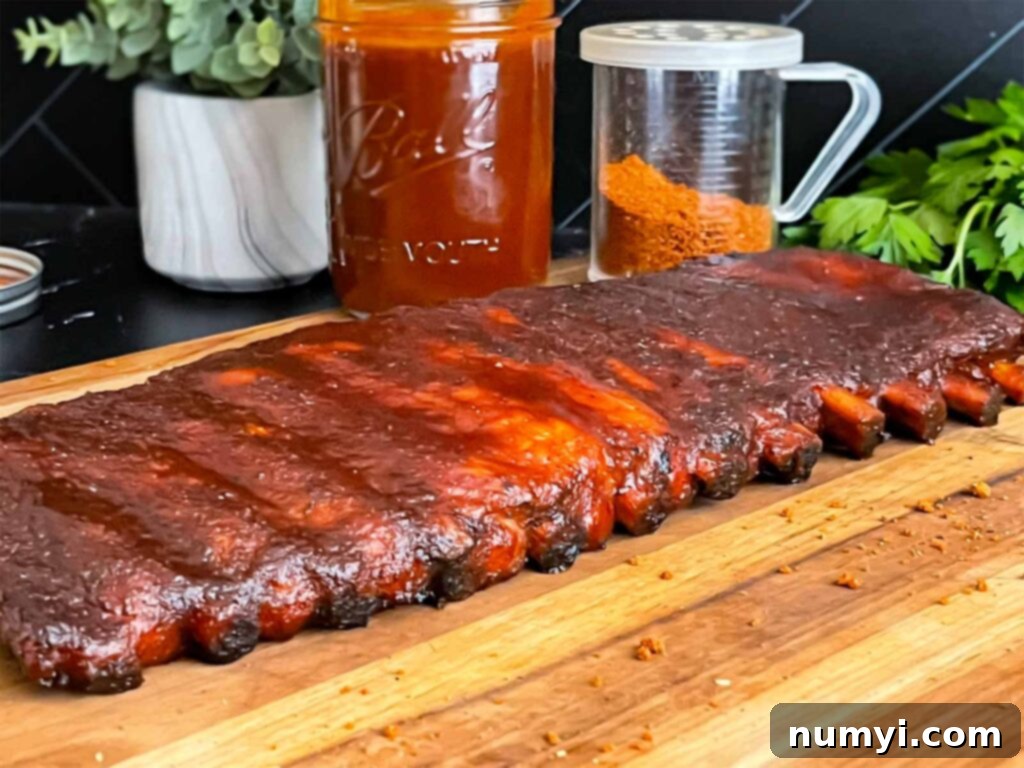
Mastering these smoked ribs with your own homemade Kansas City rub and authentic Kansas City barbecue sauce isn’t just about cooking; it’s about embracing a cherished tradition and elevating your status to BBQ royalty amongst your guests. The depth of flavor achieved through low-and-slow smoking, combined with the sweet and savory bark, is truly transformative. It’s an experience that demands to be tried and shared.
For an authentic and superior flavor, we highly recommend using our homemade Kansas City style rub and our rich, homemade Kansas City style Barbecue sauce. These recipes are crafted to complement each other perfectly, delivering that quintessential Kansas City taste. However, feel free to use your favorite store-bought options if that suits your convenience.
To complete your grand barbecue feast, don’t forget the essential side dishes. Nothing pairs better with these ribs than classic Barbecue baked beans, a creamy and tangy classic Southern potato salad, and a refreshing macaroni salad. These sides are the perfect accompaniment to balance the richness of the ribs and elevate your entire meal.
Crafting Kansas City Ribs: A Step-by-Step Smoking Guide
Creating these incredible Kansas City ribs follows a tried-and-true method that I use for most of my rib recipes, refined to perfection for this specific style. The process involves meticulous preparation, a period of flavor development, precise smoking, a crucial wrapping stage, and a final saucing to achieve that signature sticky glaze. We’ll cover everything from selecting your rack of ribs to achieving that perfect internal temperature and bark. This recipe specifically calls for spareribs, which are known for their rich meatiness and flavor, ideal for the Kansas City style. I always trim off the brisket bone and rib tips from spareribs. But don’t worry, these trimmings are never wasted; I often smoke them alongside the main rack for a delicious chef’s snack later!
Prepare The Ribs for Maximum Flavor
Proper preparation is the foundation of outstanding ribs. While you can certainly do this right before smoking, I highly recommend preparing them the night before. This allows the dry rub ample time to “dry brine” the meat, drawing moisture out and then reabsorbing it with concentrated spice flavors, leading to a deeper, more profound taste and a better bark.
-
Begin by trimming any excess hard fat from both sides of the ribs. This ensures a better rub adherence and prevents greasy pockets. You may also optionally trim off the skirt meat, that flat piece on the backside of the ribs. For smaller servings, I sometimes leave it on, as it’s just the two of us. Crucially, remove the silverskin membrane from the back of the ribs. This tough membrane, if left on, prevents the rub from penetrating the meat and results in a chewier texture. It’s a small step that makes a huge difference in the final tenderness.
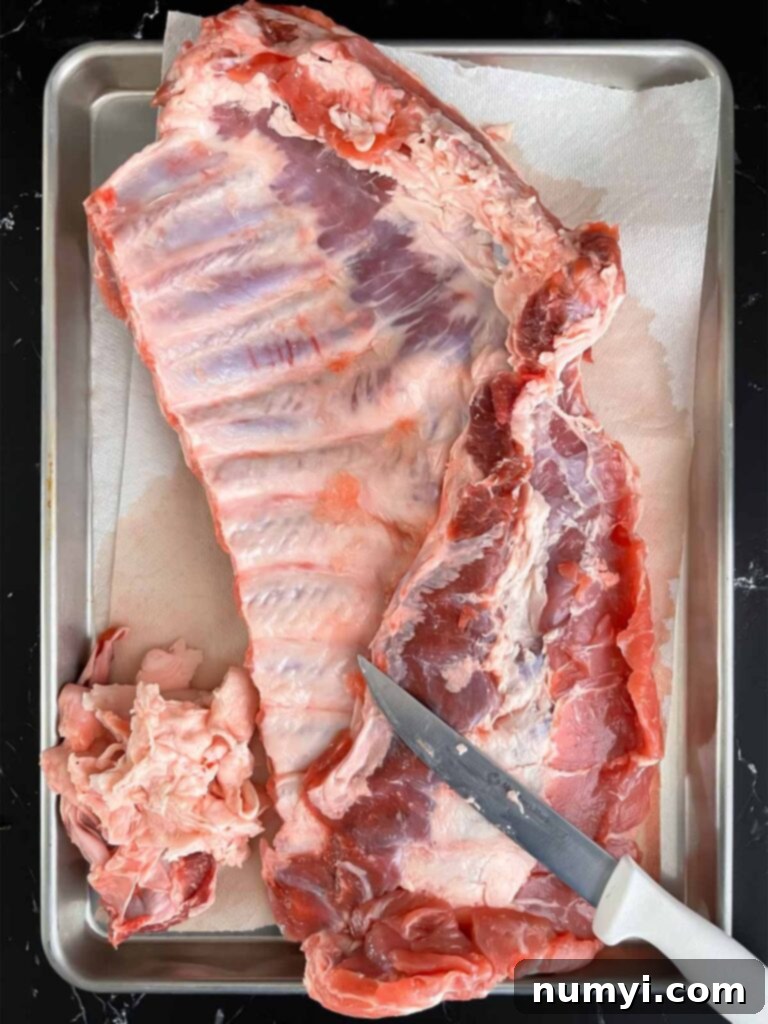
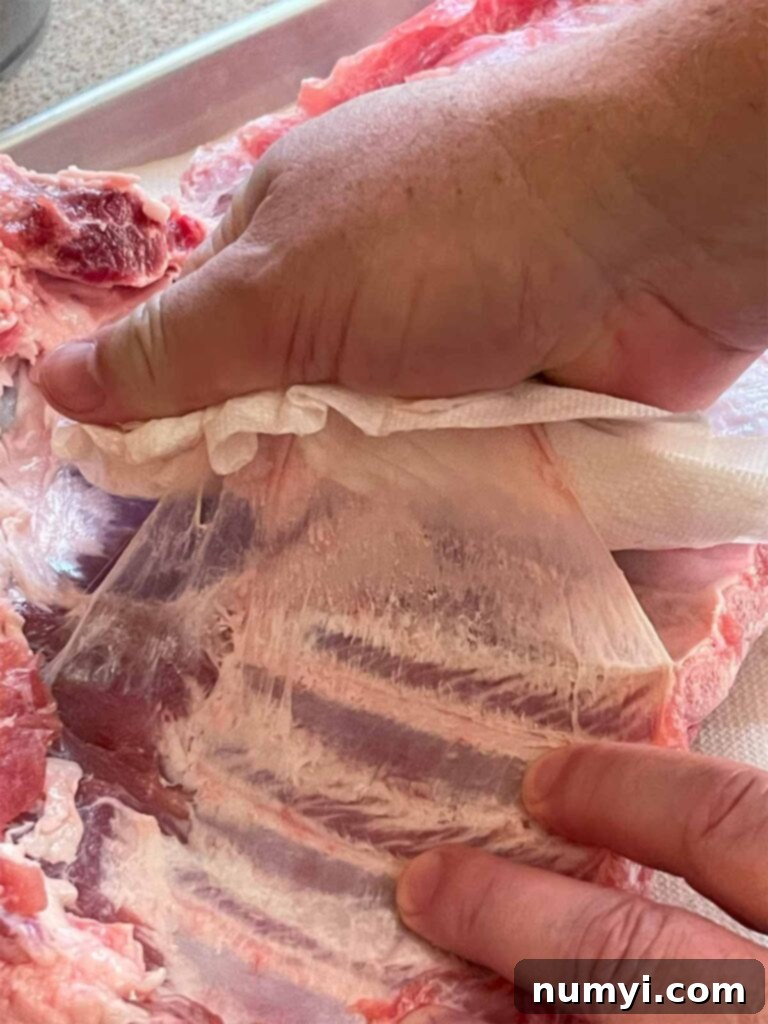
Note
Remember that trimming off the brisket bone and rib tips is only necessary if you’re working with a full rack of spareribs. Many grocery stores sell “St. Louis style” ribs, which already have these portions removed, making your prep even easier. This recipe is also incredibly versatile and works perfectly for baby back ribs, which many home cooks prefer due to their smaller size and leaner profile.
-
After trimming, apply a light coat of yellow mustard to the entire rack of ribs. While optional, mustard acts as an excellent binder, helping the dry rub adhere beautifully to the meat and creating a more even crust. Next, generously apply your chosen rub to both sides of the ribs, ensuring full coverage. Don’t be shy here; the rub is where a significant portion of that classic Kansas City flavor comes from!
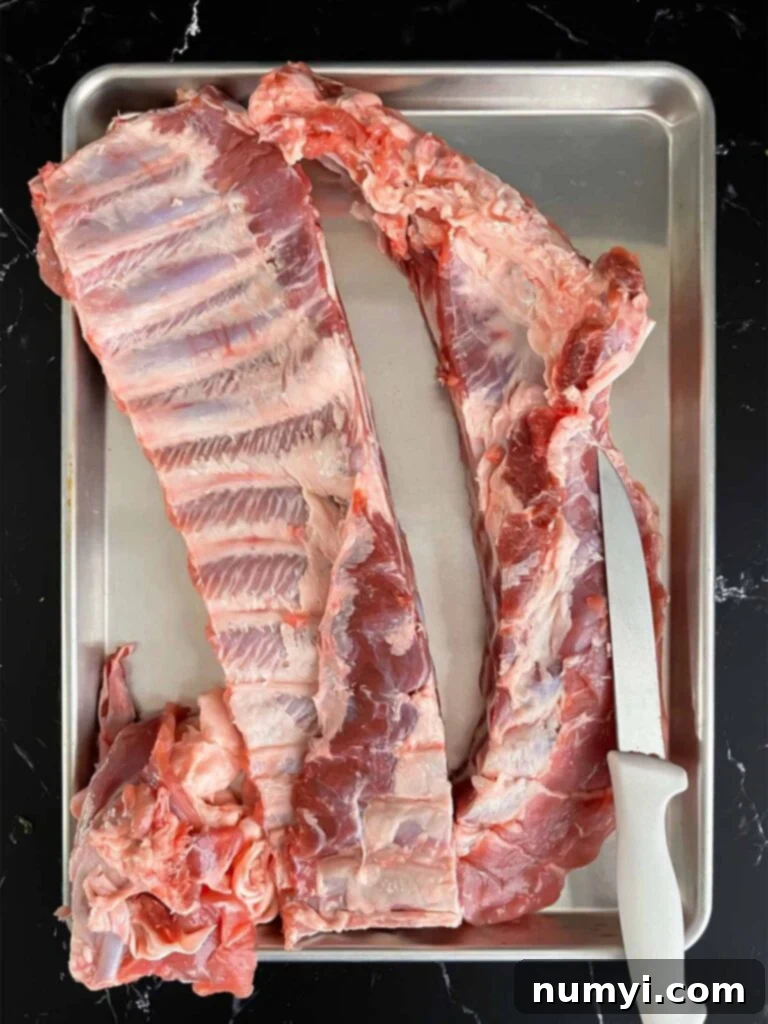

Once seasoned, cover the ribs tightly and refrigerate for at least two hours. For optimal flavor penetration and tenderness, I strongly advocate for dry brining them overnight. This extended time allows the rub’s salt to work its magic, tenderizing the meat and infusing it with flavor from the inside out.
Smoke The Ribs to Juicy Perfection
The smoking phase is where the magic truly happens, transforming the seasoned pork into tender, flavorful ribs. Before placing them on the smoker, remove the ribs from the refrigerator about an hour beforehand. This allows the meat to come closer to room temperature, promoting more even cooking.
-
Preheat your smoker to a consistent 225°F (107°C). Use hickory wood for an authentic Kansas City smoky flavor, or a blend of hickory with apple or cherry for a milder, sweeter smoke. If any moisture has been released from the ribs due to the dry brining process, gently pat them dry and apply a very light dusting of rub to refresh the surface. This ensures a dry surface for optimal bark formation.
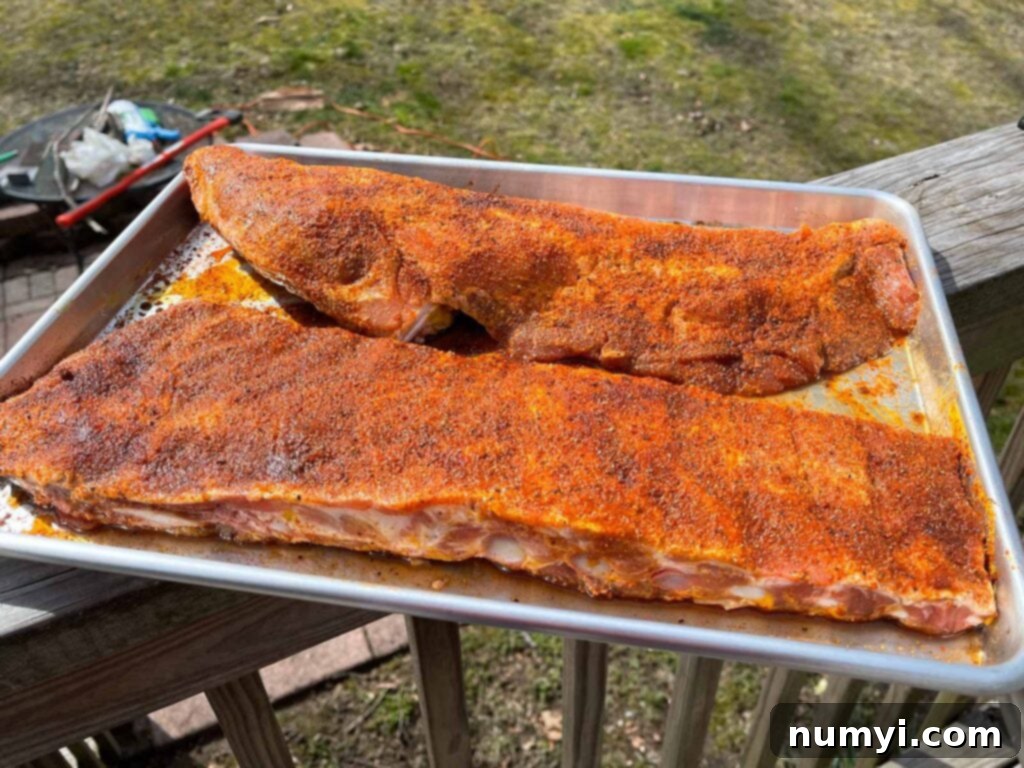
-
Carefully place the ribs directly on the smoker grates, bone side down. Smoke for approximately 2 to 2 ½ hours, or until the internal temperature reaches between 155°F (68°C) and 165°F (74°C). During this initial phase, the ribs will develop their smoke ring and begin forming a flavorful bark. After the first hour, you can optionally spritz the ribs every 30 minutes with a 50/50 mix of either apple cider vinegar or red wine vinegar and water. This spritz helps keep the surface moist, encourages smoke absorption, and contributes to a rich, crispy bark.
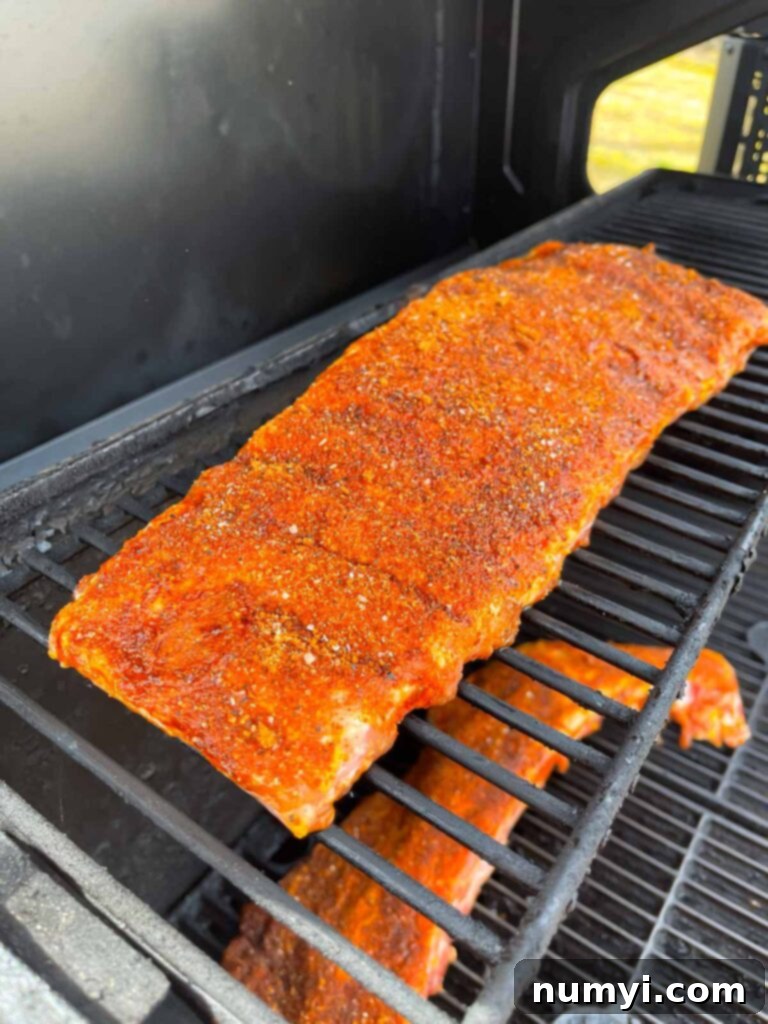
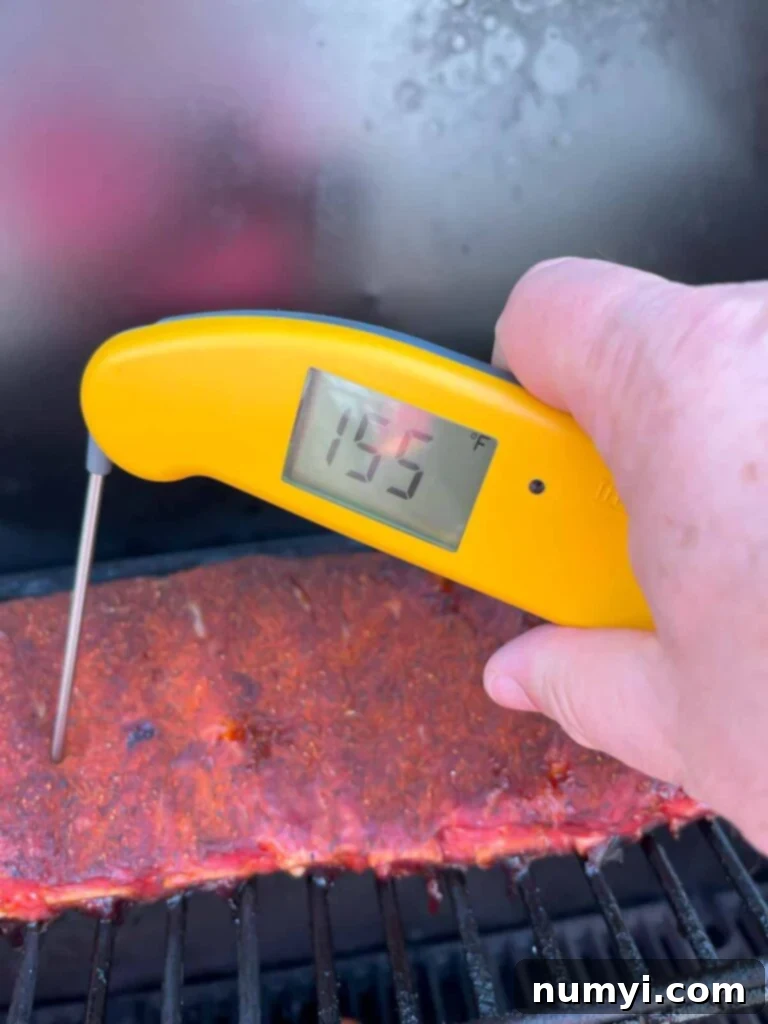
-
Once the ribs have developed a beautiful dark color and a satisfying bark, and their internal temperature has reached at least 155°F (68°C), carefully remove them from the smoker. This is the stage often referred to as the “Texas Crutch.” Prepare a couple of layers of heavy-duty aluminum foil. On the foil, distribute 4 tablespoons of unsalted butter, 2 tablespoons of honey, 1 tablespoon of red wine vinegar (or apple cider vinegar), and a generous sprinkling of the rub (about a tablespoon). This rich liquid bath will help tenderize the ribs and infuse them with even more flavor.
-
Place the ribs top side down (meat side) onto the butter mixture on the foil. This orientation ensures the meat is bathing in the tenderizing liquid. Loosely wrap the ribs, sealing them tightly to create a foil pouch that will steam and tenderize the meat. Then, return the foil-wrapped ribs to the smoker, keeping them top side down, and continue to cook for another 2 hours. This “crutch” phase rapidly breaks down connective tissue, resulting in incredibly tender ribs.

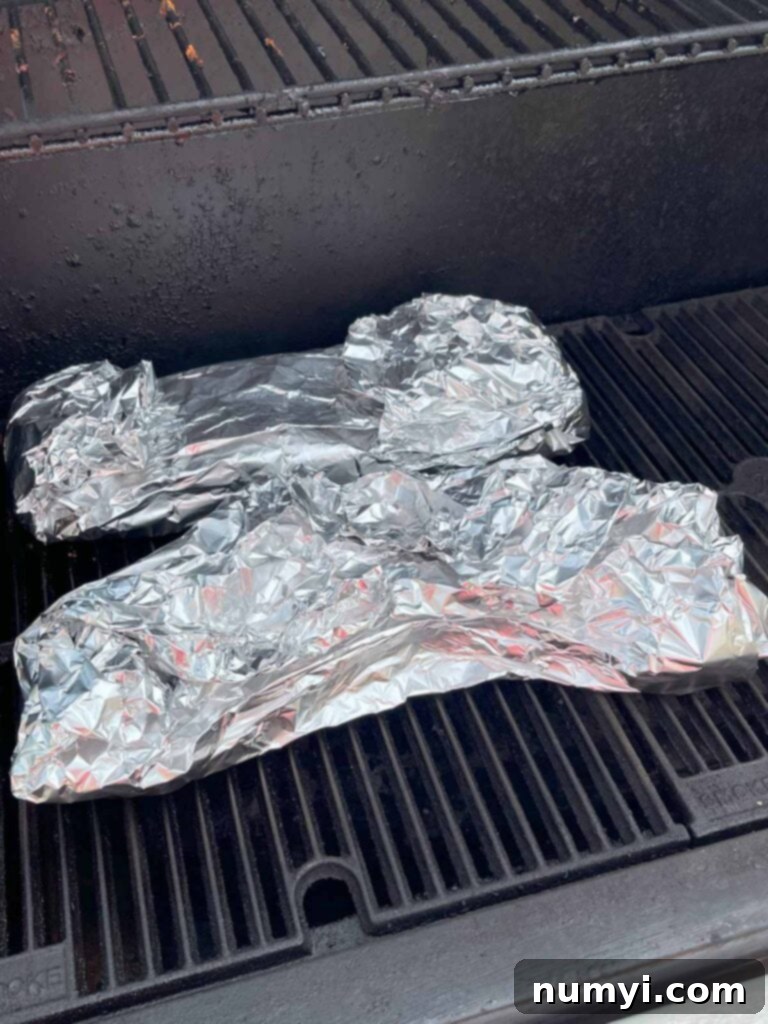
-
After approximately two hours in the foil, your ribs should be wonderfully tender. You’ll notice the meat beginning to pull back from the bones, a classic indicator of readiness. The internal temperature should now be around 195-200°F (90-93°C). Carefully unwrap the ribs, discarding the foil and any remaining liquid. Place the ribs back on the smoker grates, bone side down. Now is the time to generously brush both sides of the ribs with your chosen Kansas City BBQ sauce. This final saucing step is crucial for developing that iconic sticky, caramelized glaze.

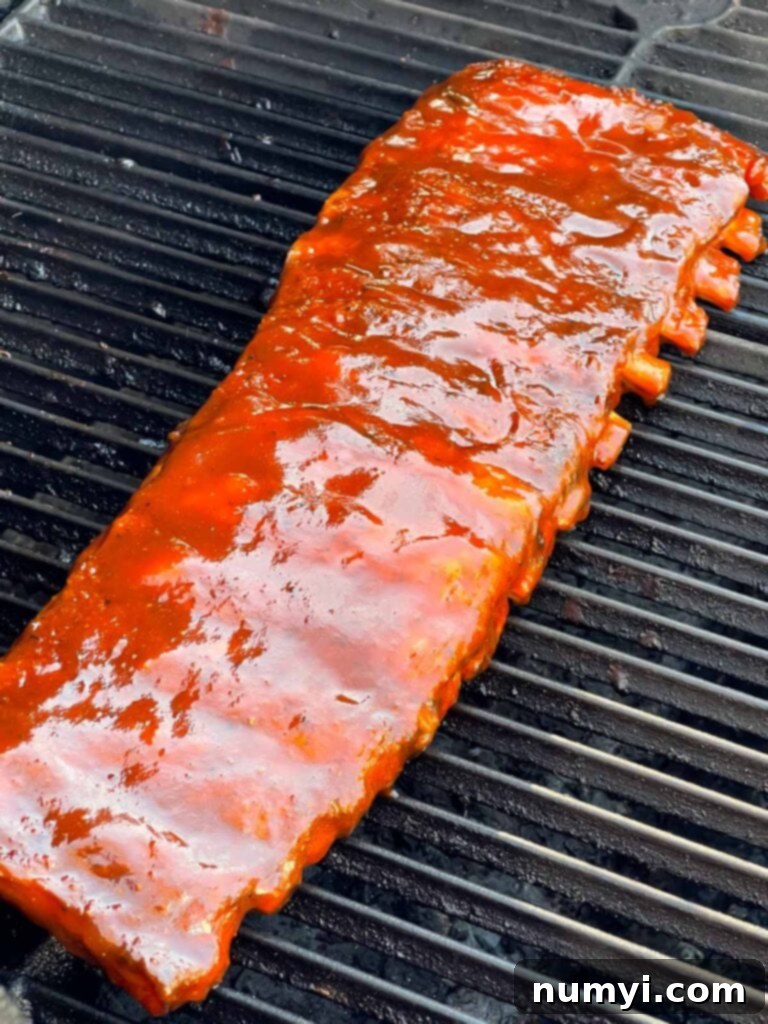
-
Continue cooking the sauced ribs on the smoker for another 30 minutes. This final stage allows the barbecue sauce to properly set and caramelize, forming that glorious, glossy, and slightly tacky finish that Kansas City ribs are famous for. This is where the sauce adheres perfectly to the bark. Once the sauce is set, remove the ribs from the smoker and, if you can resist, allow them to rest for about 5-10 minutes. This resting period helps the juices redistribute, resulting in even more succulent meat.
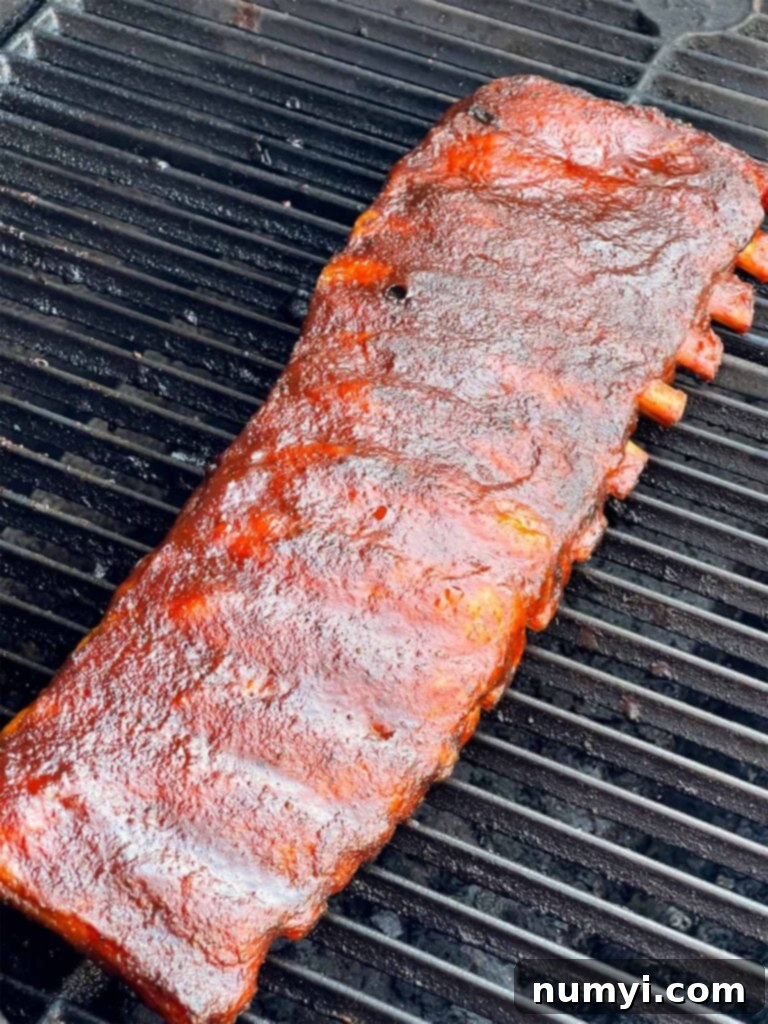
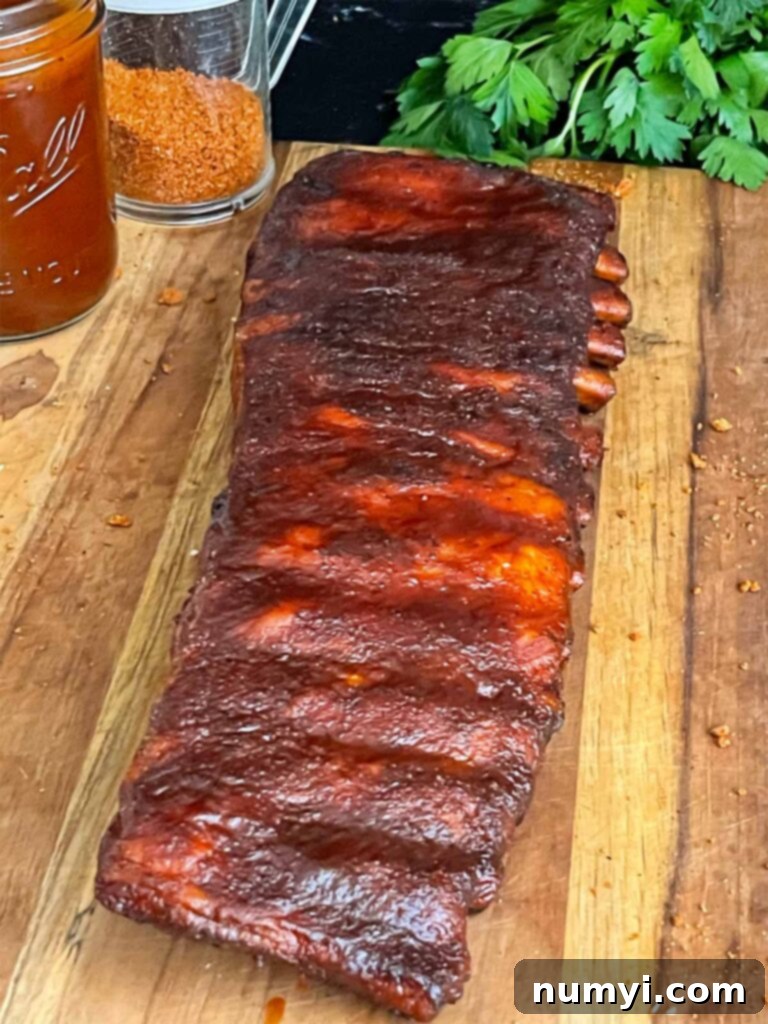
-
Once rested, slice the ribs between the bones and serve immediately. Prepare for a chorus of compliments and satisfied sighs!
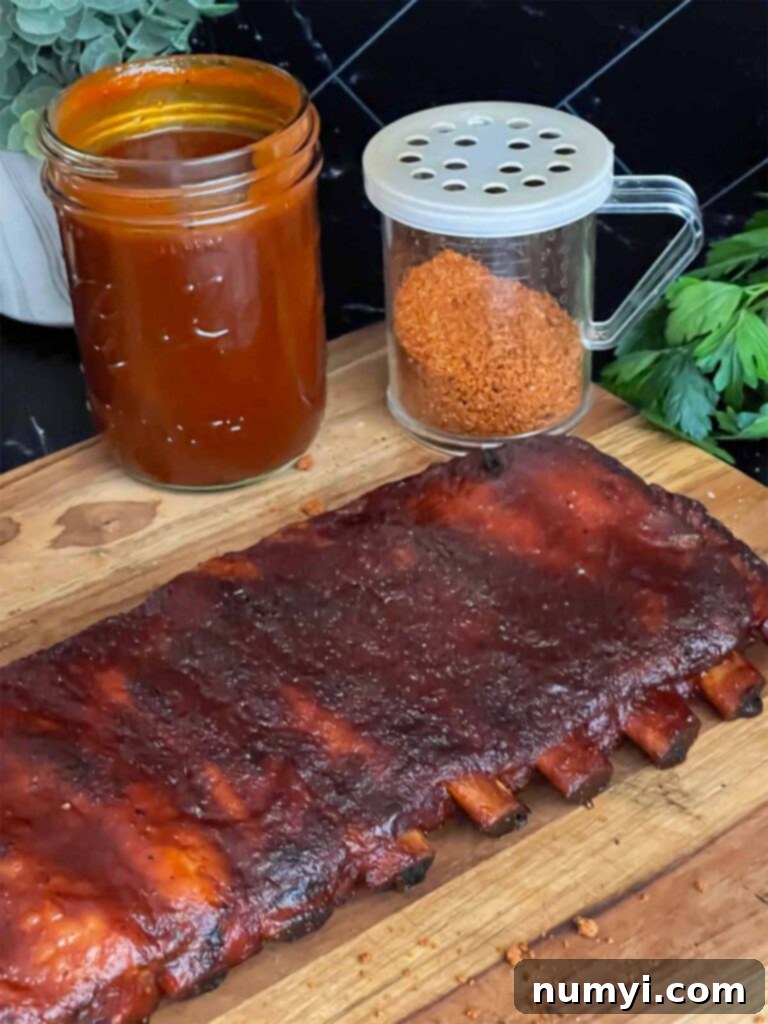
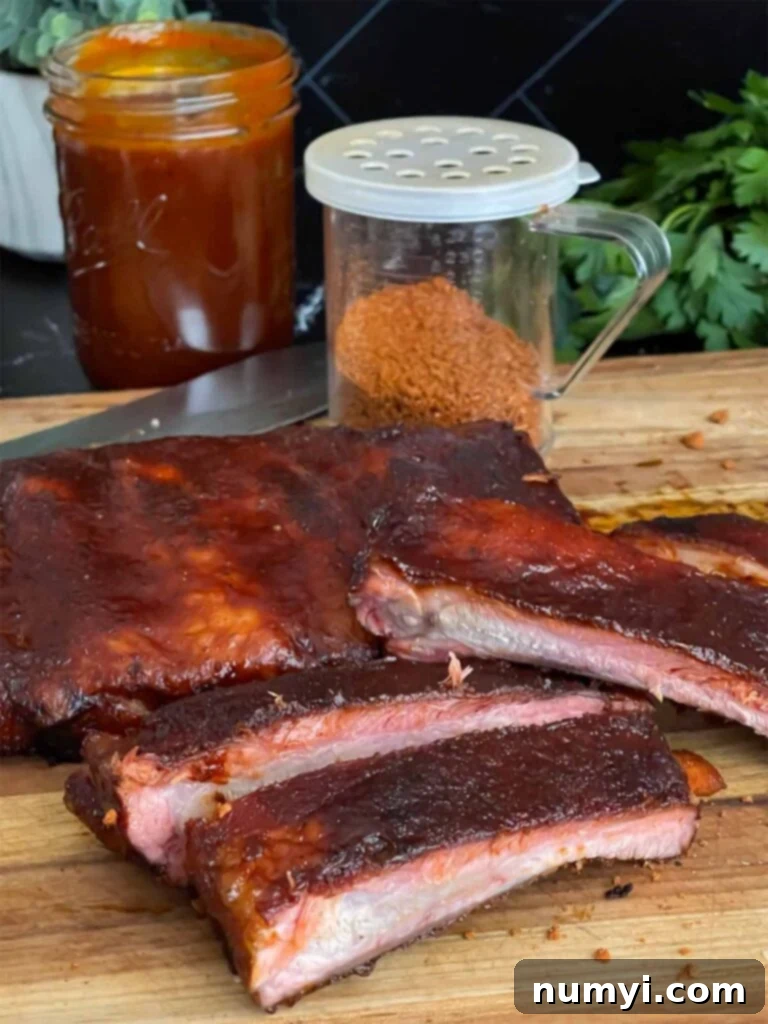
These ribs are truly BBQ in its purest, most indulgent form—the kind of saucy, smoky, fall-apart magic that instantly transports you to the vibrant heart of Kansas City barbecue country. If you’re seeking that classic, deeply satisfying smoked rib experience, look no further. This recipe is your definitive guide to achieving barbecue greatness.
Enjoy every glorious, sticky bite!
Expert Tips for Unforgettable Ribs
- Trim for Even Cooking: When using spareribs, trimming off the brisket bone and rib tips (to create St. Louis style ribs) is essential for uniform thickness. This ensures that the entire rack cooks evenly, preventing thinner sections from drying out while thicker parts finish cooking. Don’t discard these flavorful trimmings; smoke them separately for delicious, meaty bite-sized snacks. My wife absolutely loves these!
- Dry Brine for Enhanced Flavor: Allowing the rub to penetrate the meat overnight (the dry brining process) is a game-changer. The salt in the rub draws moisture out, which then mixes with the spices and is reabsorbed, deeply seasoning the meat and tenderizing it from within. This results in a much more flavorful and juicy rib.
- Don’t Skip the Spritz: The occasional spritz of apple cider vinegar and water during the initial smoking phase serves multiple purposes. It helps keep the surface of the ribs moist, which aids in smoke adherence, contributes to a robust bark formation, and adds a subtle layer of tangy flavor that complements the richness of the pork.
- Wrap for Ultimate Tenderness (The “Texas Crutch”): Wrapping the ribs in foil with a liquid bath of butter, honey, and vinegar during the middle cooking stage is a secret weapon for achieving incredibly tender ribs. This method steams the meat, rapidly breaking down connective tissues and ensuring a fall-off-the-bone texture while keeping the ribs moist.
- Sauce at the Right Time: Apply your Kansas City barbecue sauce during the final 30 minutes of cooking, directly on the smoker. This crucial timing allows the sugars in the sauce to caramelize and set into a beautiful, glossy glaze without burning, ensuring a sticky, flavorful finish.
Exciting Variations to Explore
- Dry Rub Only (Memphis Style): For those who prefer a more traditional “dry” rib, skip the final sauce application entirely. Focus on building an exceptional bark with your rub and enjoy the pure, intense smoky flavor that defines a true dry-rubbed rib, often associated with Memphis barbecue.
- Spicy Kick: If you crave some heat, incorporate a teaspoon of cayenne pepper into your dry rub recipe, or add a few dashes of your favorite hot sauce to your Kansas City barbecue sauce before the final glazing step. This will add a vibrant, fiery dimension to your ribs.
- Honey-Butter Glaze: For an extra-glossy, intensely sweet, and sticky finish, brush the ribs with a mixture of melted butter and honey during the last 10-15 minutes of cooking. This creates an irresistible candy-like coating that’s perfect for those with a sweet tooth.
- Whiskey Twist: Elevate the complexity of your ribs by swapping out the vinegar in your foil wrap for a splash of bourbon or whiskey. The alcohol will evaporate, leaving behind a rich, deep, and subtly sweet flavor that beautifully complements the pork and smoke.
- Different Woods, Different Flavors: While hickory is the traditional choice for Kansas City BBQ, experimenting with different smoking woods can introduce new flavor profiles. Try mixing in fruit woods like cherry or apple wood for a slightly sweeter, milder smoke. Oak provides a stronger, more classic barbecue flavor, while pecan offers a nutty undertone.
Frequently Asked Questions About Kansas City Ribs
Absolutely! This recipe works wonderfully with baby back ribs. Keep in mind that baby backs are typically smaller and leaner than spareribs, meaning they will cook faster. You’ll likely need to reduce the smoking time in each phase by about 30-60 minutes, focusing more on tenderness cues rather than strict timing.
There are several indicators. The most common is the “bend test”: gently lift the rack of ribs with tongs in the middle. If the meat cracks slightly and feels flexible, it’s a good sign. The meat should also have pulled back from the ends of the bones by about half an inch. The internal temperature will typically be between 195-205°F (90-96°C) when they are perfectly tender, but temperature is less crucial than feel for ribs.
No smoker? No problem! You can achieve excellent results in your oven. Preheat your oven to 275°F (135°C). Place the seasoned ribs on a rack over a baking sheet with a small amount of water in the bottom to create moisture. For that smoky flavor, add a few drops of liquid smoke to your rub or barbecue sauce. Follow the same “3-2-1” principle (3 hours uncovered, 2 hours wrapped, 1 hour sauced) for roughly similar timing, adjusting based on tenderness.
Yes, it’s highly recommended unless you prefer a chewy texture. The membrane (silverskin) is tough and unappetizing. Removing it allows the rub and smoke to penetrate the meat more effectively, resulting in much more tender and flavorful ribs. It’s a simple step that significantly improves the eating experience.
Discover More Amazing Barbecue Rib Recipes
Smoked Baby Back Ribs Recipe
St. Louis Ribs – Learn How To Do Smoked Ribs Like A Pro
Fall Off The Bone St Louis Style Ribs
Are you on Pinterest? Click the button below to add this recipe to one of your boards!
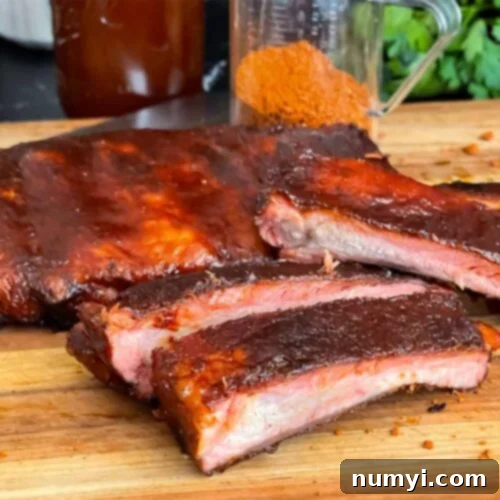
Kansas City Barbecue Ribs Recipe
Print
Pin
Rate
barbecue
American
10 minutes
5 hours
4
Ingredients
-
1
rack spare ribs
trimmed St. Louis style
-
2
tbsp
yellow mustard
binder, optional
-
½
cup
Kansas City-style BBQ rub
homemade or store-bought
For Spritzing (Optional):
-
½
cup
apple cider vinegar
or red wine vinegar
-
½
cup
water
For Wrapping:
-
4
tbsp
unsalted butter
-
2
tbsp
honey
-
1
tbsp
apple cider vinegar
or red wine vinegar
-
1
tbsp
Kansas City-style BBQ rub
For Finishing:
-
1
cup
Kansas City-style BBQ sauce
Instructions
Prep the Ribs:
-
Trim excess fat and remove the membrane from the back of the ribs.
-
Coat ribs lightly with mustard (optional) and apply rub generously on all sides.
-
Cover and refrigerate for at least 2 hours, preferably overnight.
Smoke the Ribs:
-
Preheat smoker to 225°F with hickory wood.
-
Place ribs on the smoker, bone side down.
-
Smoke for 2 ½ hours, spritzing every 30 minutes if desired.
Wrap for Tenderness:
-
Lay out two sheets of heavy-duty foil. Add butter, honey, vinegar, and rub.
-
Place ribs meat side down on the mixture and wrap tightly.
-
Return to the smoker for 2 more hours, or until ribs reach 200°F internal temp.
Finish with Sauce:
-
Carefully unwrap ribs and place them back on the smoker.
-
Brush generously with Kansas City BBQ sauce on both sides.
-
Cook for 30 minutes, allowing the sauce to set.
Rest & Serve:
-
Remove ribs from the smoker and let them rest for 5-10 minutes.
-
Slice between the bones and serve hot.
-
Enjoy those smoky, sticky, fall-off-the-bone Kansas City ribs!
